Treasure hunters
|
Two divers conduct an underwater archaeological search. Photos courtesy of Zhang Wei |
Nearly two decades ago, Zhang Wei and two other colleagues dived into a sea to search an 800-year-old merchant vessel.
It was in November and the water temperature had dropped to 15 C. The cold water next to Zhang's skin was like a sheet of metal. Even worse, it was so dark that the archaeologist couldn't see his hands before his face. He groped around slowly but the ship didn't show up, as if it was playing hide-and-seek with him.
After half an hour of searching, the Beijinger had found nothing but a small piece of deck.
This was the first time the director of the Underwater Archaeology Research Center of China (UARCC) tried to explore Nanhai No 1, the oldest and biggest ancient vessel discovered on the "Marine Silk Road" of the South China Sea.
Last year the boat was entirely salvaged from the sea by UARCC. Now, it sits in a museum in Guangdong province.
"The biggest achievement in my life is not discovering Nanhai No 1," Zhang reveals, surprisingly, "It is about establishing the underwater archaeology team and expanding the membership from one to 50," he says with a pride.
A few years ago, Zhang, 53, stopped archeological diving because of his age. He now directs a diving team.
Zhang developed an interest in history as a child. Later, he was among the first group of students to sit the university entrance examinations after they were started again in 1977.
In 1982, the archaeology graduate of Peking University embarked on excavations of Shang Dynasty (c.1600-1100 BC) ruins in Shanxi and Henan provinces.
"Archaeology is boring, as you have to repeat the same thing everyday," Zhang confesses. "On the other hand, you will eventually discover something that might not shock the world but help explain more about history."
According to Zhang, world famous salvage diver Mike Hatcher was greatly involved in the development of archaeological diving in China.
The British diver discovered the wreck of Geldermalsen (or the Nanking cargo) in 1985 in South China Sea. A year later, he auctioned the treasure in Amsterdam.

Two Chinese antique experts were sent to the Netherlands in an attempt to purchase them back. Sadly, they had no opportunity to raise their bidding paddle, as they even couldn't afford the starting price.
By the end, Hatcher earned more than $20 million from the auction, turning him into the richest "salvage diver" at that time.
The history of maritime trade in China can be traced back to the Qin and Han dynasties (221BC-25AD). Various types of porcelain were sent extensively to Africa, the Arab region and even Turkey in the Tang Dynasty (AD618-907), and the trade reached its peak in the Song Dynasty (960-1279).
At that time, some Southeast Asian countries - Indonesia and the Philippines, for instance - were important transfer stations for Chinese cargo vessels.
Zhang was asked if he was interested in embarking on underwater archaeology when the young man was excavating outdoors in Shandong in 1986.
"I was in a dilemma," he recalls.
"If I continued field archaeology, making a big discovery of the ruins of the Shang Dynasty would be just a matter of time, while the underwater archaeology was still virgin ground in China at that time, with no people, no equipment and no basic knowledge."
Zhang was attracted by the challenge and finally made up his mind to become China's first underwater archaeologist.
In 1987, he and his colleague Yang Lin were sent to the Netherlands to participate in a two-month salvage operation on an ancient ship. The Dutch team was shocked to learn that Zhang and Yang didn't know how to dive. So, the two received two weeks of intensive training before they were able to embrace the deep sea.
Zhang makes few references to the hardships during that period, except to say that he was always hungry.
He didn't like cheese and for lunch all he would eat was a small package of chips and fruit. Zhang was also reluctant to buy himself more food, as he wanted to save money to buy his family a color TV.
"Every time I dived into a sea seeing lots of big sea cucumbers, my mouth could not help watering," Zhang recalls, laughing out loud.
"But I was told not to touch anything. Dutch people have a strong sense of environmental protection, this is something we should learn from them."
Founded in 1987, UARCC started to expand two years later, after 16 people were selected from some provincial archaeological institutions. All of them were male, aged between 20 and 30.
Currently there are two female archaeologists in the 50-member team.
Underwater archaeology usually costs 10 times the price of land excavation, as it requires advanced equipment, Zhang says.
Visibility in Chinese waters is not good, partly due to pollution and partly because of river estuaries, which wash tons of sand into the sea. The best time for excavation is from March to May in the South and East Seas and from June to August in Bohai Bay in the north.
Archaeologists cannot begin their dive until the tide goes out. Sometimes, Zhang and his colleagues have to work in the middle of the night.
Normally, archaeologists work in pairs. The dive time is limited to no more than 40 minutes per turn, based on the diving depth.
Once Zhang was diving at a depth of 20m in Changdao island, Shandong province. He was so entranced by the spectacular flowers and plants that he didn't notice his oxygen was running out until the alarm sounded.
In a matter of seconds Zhang threw off all heavy belongings including the oxygen bottle, and swam to the surface without considering the pressure reduction. Luckily, he wasn't injured, but it certainly has made him become more cautious when working underwater.
Normally, it takes several years to salvage an ancient sunken ship. After locating the boat, the team must draw a map and excavate layer by layer.
"Our equipment has improved over the past few years. Even so, we cannot compete with those illegal salvage divers," Zhang says.
Since 1998, UARCC has been looking for underwater antiques around China's coasts. The organization has finished research in Guangdong and is now in Zhejiang, before moving on to Shandong. The survey is due to finish in 2018.
(China Daily 05/06/2008 page18)















